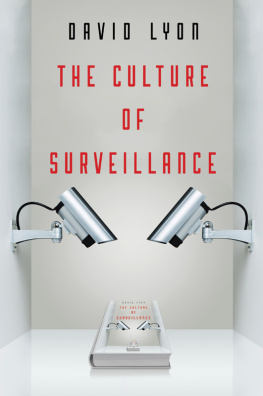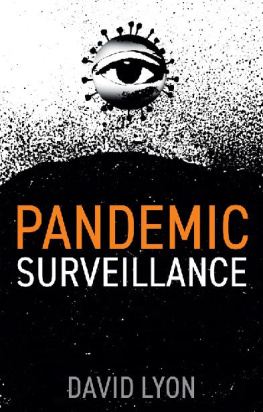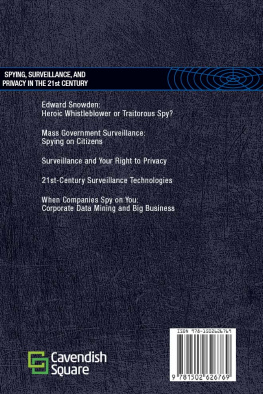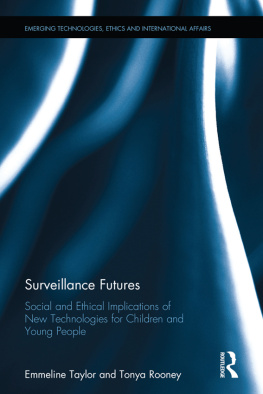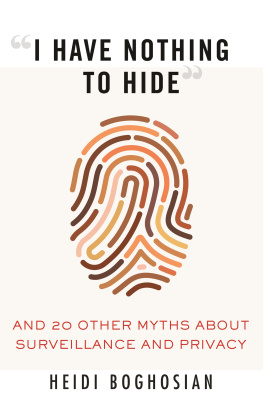
Copyright page
Copyright David Lyon 2018
The right of David Lyon to be identified as Author of this Work has been asserted in accordance with the UK Copyright, Designs and Patents Act 1988.
First published in 2018 by Polity Press
Polity Press
65 Bridge Street
Cambridge CB2 1UR, UK
Polity Press
101 Station Landing
Suite 300
Medford, MA 02155, USA
All rights reserved. Except for the quotation of short passages for the purpose of criticism and review, no part of this publication may be reproduced, stored in a retrieval system or transmitted, in any form or by any means, electronic, mechanical, photocopying, recording or otherwise, without the prior permission of the publisher.
ISBN-13: 978-0-7456-7172-7
ISBN-13: 978-0-7456-7173-4(pb)
A catalogue record for this book is available from the British Library.
Typeset in 10.5 on 12 pt Sabon
by Fakenham Prepress Solutions, Fakenham, Norfolk NR21 8NN
Printed and bound in by the UK by CPI Group (UK) Ltd, Croydon, CR0 4YY
The publisher has used its best endeavours to ensure that the URLs for external websites referred to in this book are correct and active at the time of going to press. However, the publisher has no responsibility for the websites and can make no guarantee that a site will remain live or that the content is or will remain appropriate.
Every effort has been made to trace all copyright holders, but if any have been inadvertently overlooked the publisher will be pleased to include any necessary credits in any subsequent reprint or edition.
For further information on Polity, visit our website: politybooks.com
Acknowledgements
The more I got into this piece of writing, the more I realized that such an ambitious project is rife with risks. I set out to pull together in one place much marvellous scholarship on the everyday experience of surveillance, that I think adds up to a culture of surveillance. I also wanted to wean people away from George Orwell Im a believer in breastfeeding and its wholesome benefits, so read this rightly! and to invite readers to consider other fictional accounts suited to the present, in particular, Dave Eggers The Circle. And on top of that, I hoped to show that however enjoyable or innocent some aspects of surveillance might appear, they cannot safely be seen separately from the powerful forces of consumer, or now, surveillance capitalism, or of administrative, national security and policing surveillance.
So it is with a great sense of gratitude to many people that I acknowledge help from many quarters, starting at home. My life-partner, Sue, has not only survived another book but has done so with patience and grace even though my distractions did wear these thin at times. What she demonstrates is captured in an ancient Hebrew word hesed, meaning steadfast love. Other family members, in turn, both children and grandchildren, have borne with this project, with only occasional eye-rolling. They recognize my desire to make a difference, to offer to their generations ways of understanding and responding to the accelerating changes occurring each day; to help them live with hope.
My students and colleagues, especially those at Queens University, have encouraged and challenged me with their comments and stories. Graduate students, in particular, have helped me see surveillance culture in broader ways than I originally envisioned. And what can I say to those who actually read drafts of the book sometimes returning to reread a new version? My thanks are heartfelt, to Kiyoshi Abe, Kirstie Ball, Maggie Berg, Amos Cohoe, Pablo Esteban Rodrguez, Kevin Haggerty, Gary Marx, Lucas Melgao, Torin Monahan, Mike Nellis, Midori Ogasawara, Brittany Shales, Emily Smith, Val Steeves, John Thompson and Daniel Trottier. Mary Savigar and Ellen MacDonald-Kramer at Polity, plus two anonymous readers, also directed me to rethink some aspects of the book. All their insights were invaluable to me; how I used them is entirely my responsibility, of course. The steady background work of Emily Smith and Joan Sharpe at the Surveillance Studies Centre also enables such endeavours as this to flourish. I am grateful too to Ann Bone for copy-editing and to Jean Whitaker, who kindly made the index.
Over the past few years several kind people have invited me to speak on surveillance culture and this has led to worthwhile conversations, critical comments and encouragement to persist with the project. As far back as 2010, Tom Lauer and Albert Meehan brought me to speak in their SurPriSe programme at Oakland University. I discussed Facebook and Homeland Security. In 2012, Gavin Smith, now at Australian National University, invited me to lecture for Sydney Ideas, recorded for ABC and online. A variant, The emerging surveillance culture, appears in Andr Jansson and Miyase Christensen, eds, Media, Surveillance, Identity (New York: Peter Lang, 2014). Parts of . Pablo Esteban Rodrguez invited me to speak at LAVITS, the Latin American Surveillance Studies Network, in Buenos Aires, Argentina in 2016, where my topic resembled Surveillance culture: engagement, exposure, and ethics in digital modernity, which appeared in the International Journal of Communication 11 (2017).
Kingston, Ontario
Introduction: Surveillance Culture Takes Shape
Beyond Big Brother
Pick up any book on surveillance and most make reference to Big Brother or an Orwellian future. George Orwells classic dystopian novel, Nineteen Eighty-Four, written in 1948, has informed and infused a popular sense of what surveillance entails for over half a century. There was, writes Orwell, no way of knowing whether you were being watched at any given moment. Thus, he went on, the inhabitants of Oceania lived their daily lives from habit that became instinct in the assumption that every sound you made was overheard, and, except in darkness, every moment scrutinized. It is those habits that become instinct that speak of surveillance culture where, in the case of Oceania, the citizens vision of the world was dominated by the screen warning that Big Brother is watching you and their everyday practices mirrored that menacing reality.
But this book proposes that to understand surveillance culture, Nineteen Eighty-Four must be put on one side. Not that Orwell had nothing to say far from it; his work is still deeply relevant, depicting some features distressingly familiar to many who lived through the twentieth centurys dictatorships, warning against a subtle slide into state control within supposed liberal democracies and urging readers to seek a world of decency, tolerance and humanity. Rather, my message is that Big Brother is the wrong metaphor for surveillance today. To persist with the language of a totalitarian tyrant who threatens his victims with ravenous rats and kicking jackboots simply deflects attention from what is actually going on in the world of surveillance. Some surveillance situations are indeed sinister and sadistic and are rightly deplored as such. But most peoples experience of surveillance today is not like that, which is why going beyond Big Brother is necessary now more than ever.
In the early 1990s, in my book The Electronic Eye, I observed that for all that may be learned from Orwell, he could not have guessed at the role that new, computer technologies on the one hand, and consumerism on the other, would play in creating surveillance as it was evolving in the late twentieth century. But I have since been obliged to recognize that surveillance has moved on again. What is experienced in the twenty-first century now depends deeply on the participation of those being surveilled. Indeed, as I suggest in this books subtitle, not only being watched but watching itself has become a way of life. Orwells characters lived in gnawingly fearful uncertainty about when and why they were watched. Todays surveillance is made possible by our own clicks on websites, our texting messages and exchanging photos. Ordinary people contribute to surveillance as never before. User-generated content engenders the data by which daily doings are monitored. This is how surveillance culture takes shape.
Next page
